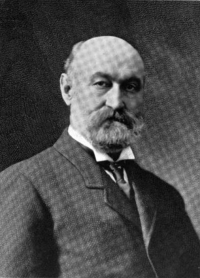 This version (2023/07/12 18:18) is a draft.
This version (2023/07/12 18:18) is a draft.Approvals: 0/1
This is an old revision of the document!
Francis H. Kimball
Francis H. Kimball (September 24, 1845–December 20, 1919), known as the father of the modern skyscraper, was an American architect best known for co-designing several skyscrapers in lower Manhattan, including the Empire Building and the Casino Theatre. Kimball, along with William Burges, helped design Trinity's “new campus” that included the Long Walk and its buildings in the form of quadrangles in 1875. Kimball also designed Northam Towers in 1881.
In 1872, Trinity trustees agreed to sell the desirable old campus property to the City of Hartford for its new Capitol building. The trustees had yet to find a new location, but President Abner Jackson wanted to be prepared with a plan. That summer, Jackson traveled to England seeking an architect to design buildings for Trinity's new campus that would be distinctively collegiate and in keeping with his vision for Trinity. Jackson was introduced to yet-unknown architect William Burges, who seemed to be a good fit for the envisioned Anglican, gothic campus.
Jackson and Burges toured Oxford together “to examine the Colleges” and Jackson took notes on Brasenose, Pembroke, All Souls, Jesus and Keble Colleges, the Bodleian Library, and the Sheldonian Theatre. He then set off for Scotland while Burges began drawing initial plans for a college to include residence quarters, a dining hall, chapel, library, and theatre. Jackson was especially inspired by Trinity College, Glenalmond, a Scottish Episcopal secondary school for boys. This Trinity College had a closed quadrangle campus with a “Long Walk” façade of Victorian gothic buildings. As was customary in Anglican institutions, Trinity was designed as a series of quadrangles inspired by varied other institutions Jackson had noted. Following his first meeting with Burges, Jackson offered him the opportunity to design Trinity’s new buildings. The College thus became the only commission Burges undertook in the United States. With Jackson's inspiration and general ideas, Burges designed an elaborate, four-quadrangle plan for the new campus in September 1872, and Jackson returned home. A few short months later, the trustees purchased the Summit campus for $225,000.
After commencement 1873, Jackson returned to England to meet with Burges and finalize the plans. He brought back to Hartford in September 1873 “the most elaborate plan which had ever been designed for an American College campus.” The architectural style was described in several ways: Victorian Gothic, Early English, French Gothic, and English Secular Gothic. The original plans included four quadrangles, a chapel, library, museum, art building, dining hall, theatre, towers and spires, an astronomical observatory, professors' apartments, student quarters, and was to be “the most imposing edifice in the United States” besides the Capitol building in Washington, D.C.
The trustees were enthusiastic about Burges' plan, and construction was set to begin in April 1874. They enlisted Hartford architect Francis H. Kimball to superintend the construction. Kimball left for London in December 1873 to meet with Burges. On Sunday, April 19, 1874, however, President Jackson suddenly died, just as plans for the groundbreaking were being made. Jackson had planned to meet Kimball and Burges in England. Thomas Ruggles Pynchon, Class of 1841, was elected Trinity's new president, and plans for construction moved forward.
Kimball returned from London in October 1874 with the completed drawings and began working with President Pynchon to adapt Burges’ plans to the Rocky Ridge site. In order to cut costs, Kimball recommended that the ambitious four-quadrangle plan should be reduced to three quadrangles, and with advice from the landscape designer Frederick Law Olmsted, Kimball and Pynchon decided to situate the Long Walk on the ridge line. The trustees were enthusiastic about this plan, but agreed that the entire campus should not begin construction all at once. The Long Walk was part of the “first stage” of construction which included the Library, Dining Hall, a block of lecture rooms, and dormitories.
On July 1, 1875, following commencement on the old campus, students, faculty and staff processed to the new campus for a groundbreaking ceremony. Immediately afterward, excavation and construction officially began on the Long Walk buildings.
Sources
Public Art CT: Francis H. Kimball
Skysraper Gothic: Medieval Style and Modernist Buildings (June 8, 2017) by Kevin Murphy et al.
Trinity College in the Twentieth Century (2000) by Peter and Anne Knapp, pp. 31-33, 506-507.
The History of Trinity College (1967) by Glenn Weaver, pp. 181-185.

